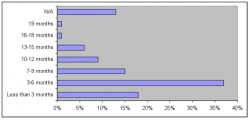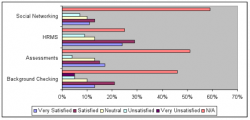 I’ve got an in-depth, 2,800-word article about implementing talent acquisition systems coming up in the November Journal of Corporate Recruiting Leadership.
I’ve got an in-depth, 2,800-word article about implementing talent acquisition systems coming up in the November Journal of Corporate Recruiting Leadership.
For now, let me give you some of the highlights.
This is all based on a survey Bersin & Associates did of talent acquisition professionals, HR practitioners, and recruiters from organizations of all sizes across all industries; the final count was 320 responses. The purpose of this survey was to obtain opinions from talent acquisition customers about the performance of their primary talent acquisition systems, to obtain information on customer satisfaction, implementation challenges, and to identify industry trends.
Time to Deploy
Through our research, we found that the average time for implementation (click on the graph to enlarge it) ranged from three months to more than a year. Since the talent acquisition market is very mature and many companies have implemented talent acquisition systems several times, the majority of organizations (36%) were able to implement this system in three to six months and few organizations took longer than a year for implementation.
 Challenges to Successful Deployment
Challenges to Successful Deployment
Before an organization implements a talent acquisition system, they need to understand and evaluate all of the potential challenges that may occur during deployment. While the majority of organizations that we spoke to during our qualitative interviews expressed frustration with the solution providers during implementation, many of these obstacles are a result of the lack of preparation and planning from the organization itself. Organizations need to standardize processes in their talent acquisition process before deploying technology. Many organizations cited the lack of a well-defined process and process changes as the top challenge during implementation. We recommend that an organization carefully review best practices in implementation and use initial benchmarks before embarking down this path.
The most common challenge that organizations face during implementation is the system’s support for all of the organization’s requirements. Similar to other talent management systems, early adopters of technology typically implemented the basic features during the implementation period. Today’s talent acquisition systems support many advanced features and can support more requirements. There is enough self-configuration and solution provider configuration options to support these hiring requirements. As a result, in our research few organizations cited “the system is too hard to use” as a top challenge.
One challenge that companies should consider during selection is the “right cultural fit” of the solution provider. During implementation, the provider and organization act as partners during this process to work together to meet requirements, roll out the system, and train employees on using the system. In this respect, the organization needs reassurance that their provider understands their business requirements and will truly act as a partner during this process.
Additional Costs
Most organizations need to set aside additional budgeting for training, configuration, and services that are often associated with implementation. Ask about additional costs not only during your solution provider evaluations but also during customer reference interviews.
The majority of organizations indicated that the amount of additional costs were minimal compared to what they expected, while 20% indicated more than expected and no additional costs. One area of concern is the 12% of companies that “don’t know” about the additional costs. Organizations and talent acquisition professionals especially should be fully aware of what they are spending on these systems in order to show the value and ROI or any discrepancies.
Integration
Integration is an essential component of talent acquisition systems. Best practice organizations consider integration during the implementation stages. Some solution providers provide integration toolkits to handle data structures and make a more seamless process. More commonly, integration should be examined on a case-by-case basis and needs to be custom-built depending on the needs of the organization.
Several years ago, the majority of organizations were not considering integration when selecting and implementing talent acquisition systems. They were making decisions without thinking about a more strategic view of talent. If integration is done correctly and can easily transfer data, organizations do not need to consider one large platform but rather individual systems that can work together. Unfortunately, integration is not a seamless process for most organizations and can cause problems for organizations that did not consider transferring this data during implementation. Today, organizations seem to be more mature in their view of identifying, developing, and retaining talent but still are not making integrating various systems a top priority. This is evident in the number of “N/A” responses with satisfaction in integration (see the graph, click it to enlarge). We recommend that organizations consider their current HRMS, talent management providers, third-party recruiting providers, Outlook, and social media when implementing their talent acquisition system.
Organizations can solve most of the challenges with integration if they begin this process during the implementation timeframe with a full team to support them including the implementation team and additional training and support.

Delivery Models
Although many of the solution providers offer multiple models, the majority of companies we research in both of our qualitative and quantitative survey results use an SaaS delivery model. Seventy-eight percent of companies access their talent acquisition over the Internet where the data is hosted externally, while only 22 percent have the ATS installed locally and running behind their organization’s firewall. The three main industries that have systems hosted internally are banking/finance, aerospace, and technology. These industries have high security needs and need to have more sensitivity around data privacy. As a result, they can not afford to take any chances in hosting these systems over the web.
SaaS has many benefits for both mid-sized and enterprise customers including affordability and scalability, but organizations need to perform due diligence and ask the following questions when implementing their systems:
- Is there a license fee cost up front? Although SaaS allows for regular payments, some providers require a large amount of money and commitment upfront.
- Is the data readily available? Organizations need to make sure they have all the information they need on their solution provider’s data center.
- Internet availability? Does your organization have Internet access for every employee in the organization?
- Does your provider offer a free trial? Many SaaS providers will offer a 30-day trial.
Global Implementation
As companies become more global in scope, implementing a talent acquisition system across multiple countries requires additional planning and support. Global implementation of a talent acquisition system can create a new set of challenges for organizations. In order to overcome obstacles such as localization and data privacy, we recommend that organizations understand both their global objectives and their local needs for each county they will be rolling out the system. Also, organizations should expect a longer implementation time when rolling out the system to various locations in order to address various across different geographical regions. Some of these global implementation challenges include:
- Differences with labor markets
- Differences in technology adoption
- Security issues/data privacy issues
- Translation resources
- Compliance and legal issues
- Gaining support from local offices
Despite these challenges, organizations will find great value in implementing a global system. Some of the benefits for organizations to implement a global system include:
- Standard quality of hire
- More consistency in the recruitment process
- Reduced costs using one system
- Increased reporting capabilities
- Increased communication
Organizations also need to plan for the future and consider what decisions and choices they will be making around their global workforce. How many languages will they need to support? Where will they expand? What support will be available? What is the level of technology adoption from region to region? Organizations should create planning committees and include representatives from each country to participate prior to implementation.
Making the Business Case
Implementing a talent acquisition system can provide results in streamlining the recruitment process and improving overall efficiency. McDonald’s UK is one example of a company that moved from a paper-based process to an online recruitment system. Shortly after, McDonald’s experienced a 30% reduction in 90-day turnover.
Although most organizations like McDonald’s UK will be able to measure this efficiency shortly after going live with their system, within the first few months of implementation, organizations need to continually evaluate and measure this efficiency to make a case for this system. The most common efficiencies experienced with the implementation of a talent acquisition system include time savings and compliance, two critical drivers of an organization’s decision to automate.